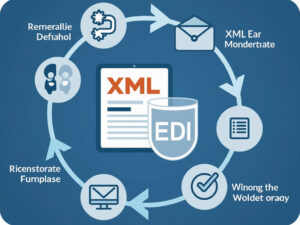Mastering the Art of XML EDI: Revolutionizing Data Integration for Businesses

In today’s fast-paced business landscape, seamless XML EDI data integration is paramount for success. Enterprises are constantly seeking innovative solutions to streamline their operations and maximize efficiency. Enter XML EDI, a game-changing technology that is revolutionizing data integration for businesses across industries.
XML EDI, short for Extensible Markup Language Electronic Data Interchange, is a standardized format for exchanging business documents electronically. It provides a structured and flexible way of sharing data between different systems, regardless of platform or language. With XML EDI, businesses can automate data exchange processes, eliminate manual data entry errors, and enhance collaboration among partners.
What makes XML EDI a powerful tool for data integration is its ability to define the structure and content of the data being exchanged. This allows for seamless communication and interpretation of data between diverse systems, paving the way for efficient and accurate decision-making.
By mastering the art of XML EDI, businesses can unlock a world of opportunities. They can experience increased productivity, reduced costs, improved customer satisfaction, and an overall competitive edge in today’s data-driven economy. So, are you ready to embrace the XML EDI revolution and take your business to new heights?
What is XML EDI?
XML EDI, or Extensible Markup Language Electronic Data Interchange, is a standardized format for exchanging business documents electronically. It is a powerful tool that allows businesses to seamlessly integrate data across various systems and platforms. At its core, XML EDI provides a structured and flexible way of sharing data, enabling efficient communication and interpretation between diverse systems.
The key feature of XML EDI is its ability to define the structure and content of the data being exchanged. This is achieved through the use of XML, a markup language that allows for the creation of custom tags and hierarchical data structures. By defining the structure of the data, XML EDI ensures that the information being shared is consistent, accurate, and easily understood by all parties involved.
Unlike traditional EDI, which often relied on rigid and proprietary formats, XML EDI offers a more adaptable and scalable solution. This flexibility allows businesses to easily accommodate changes in their data requirements, industry standards, or trading partner needs without the need for extensive system overhauls. The XML-based structure of XML EDI also makes it easier to integrate with a wide range of software applications and technologies, further enhancing its versatility and adoption across various industries.
Understanding the importance of data integration
In today’s fast-paced business environment, the ability to seamlessly integrate data across different systems and platforms is critical for success. Enterprises are constantly faced with the challenge of managing and leveraging vast amounts of data from various sources, including internal systems, external partners, and customer interactions.
Effective data integration is the key to unlocking the full potential of this data. By consolidating and harmonizing information from disparate sources, businesses can gain a comprehensive and accurate understanding of their operations, customers, and market trends. This, in turn, enables them to make more informed decisions, streamline their processes, and respond more quickly to changing market conditions.
However, achieving successful data integration is not without its challenges. Businesses often struggle with incompatible data formats, siloed information, and manual data entry processes, all of which can lead to errors, inefficiencies, and missed opportunities. This is where XML EDI steps in, offering a solution that addresses the complexities of data integration and revolutionizes the way businesses exchange and utilize their critical information.
The benefits of XML EDI for businesses
Mastering the art of XML EDI can unlock a wealth of benefits for businesses across various industries. By leveraging this powerful technology, enterprises can experience a significant boost in productivity, cost savings, and overall competitiveness.
One of the primary advantages of XML EDI is its ability to automate data exchange processes. By defining the structure and content of the data being shared, businesses can eliminate the need for manual data entry, reducing the risk of errors and improving the accuracy of their information. This automation not only enhances efficiency but also frees up valuable resources that can be redirected towards more strategic initiatives.
Another key benefit of XML EDI is its enhanced collaboration capabilities. By providing a standardized and structured format for data exchange, XML EDI facilitates seamless communication and integration between trading partners, suppliers, and customers. This seamless integration enables businesses to streamline their supply chain operations, improve order processing, and enhance customer responsiveness, ultimately leading to improved customer satisfaction and loyalty.
Common challenges in data integration and how XML EDI solves them
Despite the growing importance of data integration, businesses often face a myriad of challenges that can impede their progress. These challenges can range from incompatible data formats and legacy system integration to manual data entry and lack of standardization.
One of the most common challenges in data integration is the issue of incompatible data formats. Businesses often rely on a variety of software systems and platforms, each with its own unique data structure and file format. This can make it incredibly difficult to share information across these systems, leading to data silos and inefficient communication.
XML EDI addresses this challenge by providing a standardized format for data exchange. By defining the structure and content of the data using XML, businesses can ensure that information is presented in a consistent and easily interpretable manner, regardless of the underlying systems or platforms. This standardization not only facilitates seamless data integration but also enables efficient collaboration and decision-making.
Implementing XML EDI in your business
Implementing XML EDI in your business can be a transformative step towards achieving greater efficiency, cost savings, and competitive advantage. However, the process of implementing this technology can be complex and requires careful planning and execution.
The first step in implementing XML EDI is to assess your current data integration needs and identify the specific pain points that you aim to address. This involves analyzing your existing systems, data sources, and trading partner requirements to determine the most suitable XML EDI solution for your business.
Once you have a clear understanding of your requirements, the next step is to select the right XML EDI solution provider. This decision should be based on factors such as the provider’s industry expertise, the scalability and flexibility of their solution, and their ability to integrate with your existing systems and processes. It’s also important to consider the level of support and training provided by the XML EDI solution provider to ensure a smooth implementation and ongoing maintenance.
Best practices for XML EDI implementation
Successful implementation of XML EDI requires a well-planned and structured approach. By following best practices, businesses can ensure a seamless transition and maximize the benefits of this transformative technology.
One of the key best practices is to establish clear communication and collaboration with your trading partners. This involves aligning on the specific data formats, communication protocols, and integration requirements to ensure a harmonized exchange of information. Regular meetings and updates with your partners can help identify and address any potential issues or challenges early on in the implementation process.
Another best practice is to ensure comprehensive testing and validation of your XML EDI solution. This includes testing the data exchange process, verifying the accuracy and integrity of the data, and validating the integration with your existing systems. By thoroughly testing the solution, businesses can identify and resolve any potential issues before going live, minimizing disruptions and ensuring a successful implementation.
Tools and technologies for XML EDI
Implementing and maintaining an effective XML EDI solution requires the use of a range of tools and technologies. These tools and technologies play a crucial role in facilitating data exchange, automating processes, and ensuring the security and reliability of the system.
One of the essential tools for XML EDI is the XML parser, which is responsible for interpreting and validating the structure and content of the XML data. These parsers, such as SAX (Simple API for XML) and DOM (Document Object Model), provide the necessary functionality to read, manipulate, and transform XML data, ensuring its compliance with the defined standards.
In addition to XML parsers, businesses may also leverage other technologies, such as web services, enterprise service buses (ESBs), and business process management (BPM) platforms, to integrate their XML EDI solution with their existing systems and workflows. These technologies enable seamless data exchange, automated processing, and end-to-end visibility into the data integration processes.
Training and certification programs for XML EDI
As businesses continue to embrace the power of XML EDI, the demand for skilled professionals who can design, implement, and maintain these solutions has grown significantly. To meet this demand, a range of training and certification programs have emerged, providing individuals and organizations with the necessary knowledge and expertise to succeed in the world of XML EDI.
One of the most recognized certification programs in the XML EDI space is the Certified Electronic Data Interchange Professional (CEDIP) certification. This program, offered by the Data Interchange Standards Association (DISA), provides a comprehensive curriculum covering the fundamentals of EDI, XML, and the integration of these technologies. By obtaining the CEDIP certification, professionals demonstrate their proficiency in designing, implementing, and supporting XML EDI solutions.
In addition to industry-specific certifications, many educational institutions and training providers offer courses and programs focused on XML EDI. These programs, ranging from introductory workshops to advanced technical training, equip individuals with the skills and knowledge required to effectively leverage XML EDI in their organizations. By investing in the professional development of their teams, businesses can ensure that they have the necessary expertise to maximize the benefits of XML EDI and stay ahead of the curve.
Choosing the right XML EDI solution for your business
Selecting the right XML EDI solution for your business is a critical decision that can have a significant impact on your data integration efforts and overall business performance. With a wide range of solutions available in the market, it’s essential to carefully evaluate your specific requirements and choose a solution that aligns with your goals and priorities.
One of the key factors to consider when selecting an XML EDI solution is its compatibility with your existing systems and infrastructure. The solution should seamlessly integrate with your current software, databases, and communication protocols, ensuring a smooth and efficient data exchange process. Additionally, the solution should be scalable and flexible enough to accommodate your business’s growth and changing requirements over time.
Another important consideration is the level of support and services provided by the XML EDI solution provider. Look for a provider that offers comprehensive training, ongoing maintenance, and responsive customer support to ensure that your implementation is successful and that you can continue to leverage the full potential of the solution. The provider’s industry expertise and understanding of your specific business needs can also be crucial in selecting the right XML EDI solution.
Conclusion: Revolutionizing data integration with XML EDI
In the ever-evolving business landscape, the ability to seamlessly integrate data across diverse systems and platforms has become a critical driver of success. XML EDI, with its standardized format and flexible structure, has emerged as a game-changing technology that is revolutionizing data integration for businesses of all sizes and industries.
By mastering the art of XML EDI, enterprises can unlock a world of opportunities, from increased productivity and cost savings to enhanced collaboration and improved customer satisfaction. This powerful technology addresses the common challenges in data integration, such as incompatible data formats and manual data entry, and provides a structured and efficient solution for exchanging critical business information.
As businesses continue to navigate the complexities of the digital age, the importance of XML EDI will only continue to grow. By embracing this transformative technology and implementing best practices for its adoption, organizations can position themselves for long-term success, staying ahead of the curve and capitalizing on the vast opportunities that lie ahead.






